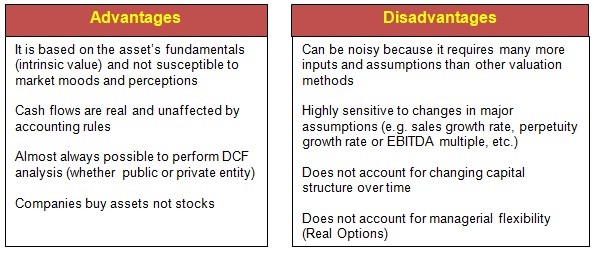Discounted Cash Flow Valuation Advantages Pitfalls
Post on: 28 Апрель, 2015 No Comment

Discounted Cash Flow (DCF) Valuation estimates the intrinsic value of an asset/business based upon its fundamentals.
Intrinsic Value of a business is the present value of the cash flows the company is expected to pay its shareholders. DCF Valuation is the basic foundation upon which all other valuation methodologies are built.
To perform Relative Valuation correctly, we need to understand the fundamentals of DFC Valuation. Similarly, to apply option pricing modelling techniques, we often need to begin with a discounted cashflow valuation. Anyone who understands DCF technique will be able to analyze and apply all other valuation methodologies, thus underlying the importance of DCF Valuation.
Discounted Cash Flow Valuation is based upon expected future cash flows of the company and its associated discount rate, which is a measure of the risk attached to the business in general and company in particular. Given these mandatory requirements to arrive at DCF Valuation, this approach is easiest to use for assets, businesses, etc. whose cashflows are currently positive and can be forecasted with some reliability, and where a proxy for risk that can be used to obtain discount rates is available. The farther we depart from this idealized setting, the more difficult and less reliable DCF Valuation will be.
Given its increasing significance in business valuations, let’s look at some of the key advantages and disadvantages associated with DCF Valuation:
Advantages
- DCF Valuation truly captures the underlying fundamental drivers of a business (cost of equity, weighted average cost of capital, growth rate, re-investment rate, etc.). Consequently, this comes closest to estimating intrinsic value of the asset/business.
- Unlike other valuations, DCF relies on Free Cash Flows. To a larger extent, Free Cash Flows (FCF) are a reliable measure that eliminate the subjective accounting policies and window dressing involved in reported earnings. Irrespective of whether a cash outlay is categorized as an operating expense in P&L, or capitalized into an asset on balance sheet, FCF is a true measure of the money left over for investors.
- Besides explicitly considering the business drivers involved, DCF allows investors to incorporate key changes in the business strategy in the valuation model, which otherwise will go unreflected in other valuation models (like relative, APV, etc.)
- While other methods like relative valuation are fairly easier to calculate, their reliability becomes questionable when the entire sector or market is over-valued or under-valued. DCF cuts across through this quandary and predicts the best possible instrinsic value.
- Most importantly, DCF model can be used as a sanity check. Instead of estimating the fair intrinsic value, the current share price of the company can be plugged into the model, and working backwards, DCF model will tell how much the company’s stock is over-valued or under-valued, and also whether the current stock price is justified or not.
Disadvantages
- DCF Valuation is extremely sensitive to assumptions related to perpetual growth rate and discount rate. Any minor tweaking here and there, and the DCF Valuation will fluctuate wildly and the fair value so generated won’t be accurate.
- It works best only when there is a high degree of confidence about future cash flows. But if the company’s operations lack visibility, it becomes difficult to predict sales, operating expenses and capital investment with certainty. While forecasting cash flows for the next few years is difficult, pushing them out perpetually (mandatory for DCF Valuation) becomes almost impossible. As such, DCF method is susceptible to error if not properly accounted for these inputs.
- One major criticism of DCF is that the terminal value comprises far too much of the total value (65-75%). Even a minor variation in the assumptions on terminal year can have a significant impact on the final valuation.
- DCF Valuation is an ever-changing target that demands constant vigilance and modification. If any expectations about the company change, the fair value will change accordingly.
- DCF Model is not suited for short-term investing. Instead, it focuses on long-term value creation.














